You could spend thousands advertising on one billboard and find out months later that it had nothing to do with any increase in your sales. Your competitor, meanwhile, had implemented a highly data-driven digital advertisement with real-time adjustments and experienced a spike in conversions. This encompasses the continuing clash of traditional marketing versus digital marketing intelligence. These days, businesses must choose either tried-and-true offline marketing or technology-powered digital insights. Which approach yields greater returns? Let’s get into it.
What is Traditional Marketing?
Definition and Key Characteristics
Traditional marketing means all the offline promotional tools minus the world of the Internet. It connects advertising messages to the audience through some physical and broadcast media. Despite the advent of digital channels, traditional marketing still finds common use in brand recognition and mass communication. Companies dividing consumers according to some geographic and demographic characteristics are the ones that use the traditional and often offline billing processes.
Common Traditional Marketing Channels
- Print Media: Newspapers, magazines, brochures, and pamphlets.
- Broadcast Media: Going on to radio and television advertisements to reach mass audiences.
- Outdoor Advertisements: Billboards, ads in transit, and posters are all placed in considerably trafficked areas.
- Direct Mail: Flyers, postcards, and catalogs sent to consumers’ mailing addresses.
- Telemarketing: Making cold calls to prospects promoting products or services.
Advantages of Traditional Marketing
- Brand Trust & Credibility: Consumers trust television advertisements and other forms of media less than few print media.
- Mass Audience Reach: Mass audiences are ordinarily targeted by broadcast television radio or billboard advertisements.
- Memorable Brand Presence: Traditional advertising creates a lasting mental picture in consumers.
- Works Well in Local Marketing: Traditional advertising works very well for small businesses operating in small regions.
Limitations of Traditional Marketing
- High Investment: Advertising on television and billboards is binding with heavy budgets.
- Hard-to-Measure: Tracking ROI is almost impossible.
- Changes Slowly: Campaign flip-flops from one program to another due to effort and time.
- Little Audience Targeting: Most often, traditional marketing goes for a wide audience, clogging its spending on ads.
What is Digital Marketing Intelligence?

Definition and Core Concepts
Digital marketing intelligence hence refers to data-driven strategies that have brought modern-day marketers closer to the ideal of optimizing marketing efforts in real-time, via analytics and AI-based insights or targeted online campaigns. Opposite to the old marketing that was based on assumption and large-segment targeting, digital marketing intelligence lets the organization understand customer performance, preferences, and purchasing patterns significantly.
Key Components of Digital Marketing Intelligence
- Real-Time Data Tracking – tracks user instantaneous behaviors for optimization of marketing strategies.
- AI in Digital Marketing & Automation – Makes use of machine learning for targeting improvements and campaign optimization.
- Personalized Marketing – This is the most accommodating delivery of content based on what users want from themselves.
- Performance Analytics_Measuring ROI, engagement, and conversions.
Common Digital Marketing Channels
- Search Engine Optimization (SEO) – Drives website rank and traffic organically.
- Pay-Per-Click (PPC) Advertising – Targets select audiences through specific paid ads on a platform like Google AdWords.
- Social Media Marketing – Involves users through sites such as Facebook, Instagram, and LinkedIn.
- Email Marketing – Automated, targeting campaigns through emails sent to the prospective customer.
- Content Marketing – Blogs, videos, and infographics to inform and interest customers.
Advantages of Digital Marketing Intelligence
- Cost-Effective- Fine as cheap as less than the set budget for both TV and print ads.
- Measurable Results- Converts engagement, conversion rates, and ROI into exact figures.
- Targeted and Personalized-reach the right audience for unique client messages.
- Real-Time Optimization- Instantaneous realignment of any campaign.
- Higher Engagement Rates- The users are kept busy with the interaction types of content.
- How to Improve Marketing Performance Using Business Intelligence – Fine-tuning results in even better results when AI-powered insights help get campaigns with the makeup.
Limitations of Digital Marketing Intelligence
- Requires Expertise_ Data analysis and strategy optimization require expert skill.
- Crowded online saturation- There is an ongoing competition for attention in the crowded online marketplace.
Digital Marketing Intelligence vs. Traditional Marketing: Which One Wins?
1. Audience Reach & Engagement
- Traditional Marketing: Masses served but not specifically targeted.
- Digital Marketing Intelligence: Reaches the correct audience at a personalized level.
Winner: Digital marketing intelligence—precision beats mass exposure.
2. Cost Efficiency & ROI
- Traditional marketing practice: Big bucks out, returns hard to track.
- Digital Marketing Intelligence: Reduces costs of campaign execution and facilitates tracking of ROI.
Winner: Digital marketing intelligence—better budget efficiency.
3. Speed & Adaptability
- Traditional Marketing: Weeks or months are required before the adjustment of a campaign.
- Digital Marketing Intelligence: Allows real-time modifications.
Winner: Digital marketing intelligence—speed matters.
4. Data & Analytics
- Traditional Marketing: Performance tracking is limited.
- Digital Marketing Intelligence: A differential in analytics and insights driven by AI.
Winner: Digital marketing intelligence—data fuels smarter decisions.
When to Use Traditional Marketing vs. Digital Marketing Intelligence
Best Use Cases for Traditional Marketing
✔ Brand awareness campaigns that are meant for larger audiences
✔ Local business promotions
✔ Industries where offline engagement matters (real estate, luxury brands)
Best Use Cases for Digital Marketing Intelligence
✔ E-commerce businesses
✔ Performance marketing is driven by data
✔ Massively scalable campaigns that can change in real-time
✔ Marketing Automation Trends – Algorithms do repetitive work for the sake of efficiency.
Future of Marketing: Combining Traditional and Digital

The better way is not to choose one over the other; it’s the use of both. Businesses should intersperse traditional methods with digital marketing intelligence for optimum results. For instance:
- – Use TV ads for brand awareness and digital ads for lead generation.
- – Print campaigns can be carried out while engagement is tracked through QR codes.
- – Interlink social media with offline events for better engagement.
Such hybrid strategies ensure a strong brand presence in various channels.
FAQs: Addressing Key Marketing Questions
1. Which marketing approach is better for small businesses?
Digital advertising intelligence helps small businesses improve marketing performance using business intelligence by targeting the right audience affordably. Compared to traditional methods, it provides very prompt data for adjustments. This maximization of reach and engagement by combining digital and traditional approaches will surely assist small businesses.
2. Can traditional marketing still be effective in 2025?
Sure, but AI takes the better option of marketing; it greatly supports tracking and engagement. In this way, print ads, TV, and direct mail build brand trust without precision on the targets. However, trends in marketing automation greatly support traditional marketing through QR codes and online analytics.
3. What role does AI play in digital marketing intelligence?
AI is being used in analyzing data, predicting trends, and automating the whole process to improve efficiency in a digital world. It helps in content personalization, ad optimization, and targeting; the insights based on AI will, therefore, allow your business to remain ahead in marketing automation trends.
4. How do I measure the ROI of my marketing strategy?
Use digital advertising intelligence tools such as Google Analytics and CRM Data to track conversions and engagement. Its performance improvement depends on how better marketing performance turns on business intelligence. Analysis must focus on KPIs for better ad targeting and budget efficiency.
Which Marketing Approach Should You Choose?
Traditional marketing has its place when it comes to broad exposure and building brand credibility. Digital marketing intelligence, going by its measurable results with targeting and cost-effective strategies, should invariably come first.
Digital marketing intelligence proves to be the best for the competitive market since it gives a good return on investment by emphasizing real-time data with strategic execution.
Ready to boost your marketing results?
Elite Digital Designs specializes in data-driven digital marketing strategies that help businesses achieve measurable growth. Contact us today to get started!

